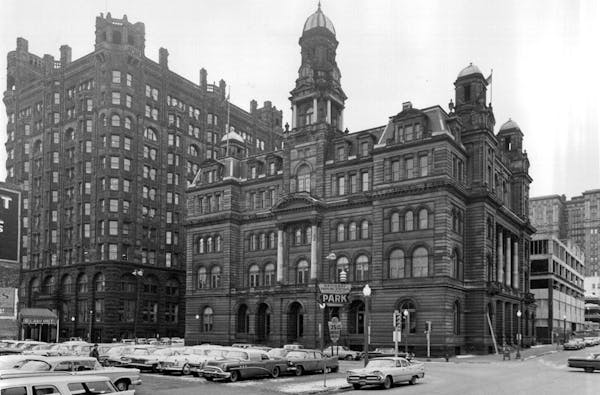Building a solid ice fortress at the St. Paul Winter Carnival is a Minnesota tradition dating to 1886. While the public long remembers these novel frozen palaces, those who designed them fade from memory. One of Minnesota's most prolific architects, Clarence "Cap" Wigington, took on the task several times, in 1937, 1940-42 and 1947. He was one of the few black American architects at this time, and designed more than 90 St. Paul city projects, including the Highland Park water tower, which was completed in 1928.
A 3-D model of his 1942 ice sculpture will be just one aspect of the exhibition "The Builders: Shaping Minnesota's Architectural Landscape on the Color Line," opening Aug. 8 at Mill City Museum in Minneapolis. It highlights Wigington's legacy and that of two other groundbreaking black men who built the Twin Cities — stoneworker Casiville Bullard and architect/stained-glass artist William Hazel.
It's organized by JoJo Bell, executive director of the roving, project-based African American Interpretive Center of Minnesota, with assistance from co-curator Acoma Gaither.
Robyne Robinson points to the importance of this exhibition, which is also supported by her firm, fiveXfive art consultants, in addition to LSE Architects, and Color Space Art and Imaging.
"The amazing things these black architects have done during those times should give us pause to think — are we weaker and wiser, are we repeating the cycles of history?" said Robinson, the new board chairwoman of the Minnesota Museum of Art in St. Paul. "While the economy may be getting better, the unemployment rates are not good. [For black men and black people in general], it is double what it is for whites."
Three showstoppers
Housed on the first floor of the Mill City Museum, this compact exhibition includes renderings and designs of Wigington from the Elmer L. Andersen Library at the University of Minnesota, Bullard's photographic prints from the archives of the Minnesota Historical Society and photos of the structures Hazel designed in the 1890s, including the interior of the Grand Opera House, at 6th Street and Nicollet Avenue. It opened in 1883 and closed in 1895.
According to the 1910 U.S. Census, Wigington was one of only 59 black architects, artists and draftsmen listed in the entire country. He was the first black municipal architect in the country, moving from Omaha to Minnesota in 1914. Within three years he had become the senior architectural designer for the city of St. Paul, where he worked for 34 years. Several of his buildings, including the Holman Field Administration Building and the Harriet Island Pavilion, are on the National Register of Historic Places.
During World War I, Wigington was instrumental in forming the 16th Battalion, Minnesota Home Guard, as a way to serve. Because of the military's racist recruiting methods, he and other black men were allowed to serve only in segregated units.
Bullard was a bricklayer and stone mason, born in Tennessee in 1871 to former slaves. He came to St. Paul in the late 19th century. Known for working on Cass Gilbert's famous Minnesota State Capitol, he also helped lay the brickwork for Wigington's Highland Park water tower, the Cathedral of St. Paul and the Foshay Tower.
Bullard was a sought-after laborer, known for his skills in stone and brickwork, and was also a member of the Bricklayers Local No. 1, something that was unusual for a black man at the time.
He built his own home, a structure that still stands as a rare example of a house built by a skilled black laborer. It is now the 1909 Casiville Bullard House in St. Paul, and is listed on the National Register of Historic Places.
While Bullard and Wigington may be known for their bigger building accomplishments, the third man in the show also contributed in political ways.
Hazel, an architect and stained-glass artist who moved to St. Paul in 1887, was one of the few black designers/salesmen for Tiffany & Co. in New York. His professional achievements were as important as the actions he took against discrimination, long before the creation of the NAACP in 1909 or the civil rights movement.
After facing discrimination by local hotels, he sued under the Minnesota Civil Rights Act of 1885, and won a small settlement. The attention his case received in the press garnered him visibility and more clients.
Bringing the historical into the present is the kind of work that Robinson feels compelled to steward.
"As a more mature person in the community, it's my responsibility to encourage curators like JoJo and Acoma to come into the fold," she said. "In the development of this community, there is so much wealth and creativity that has come from Minnesota, and I don't think people recognize that."
The Builders: Shaping Minnesota's Architectural Landscape on the Color Line When: Opening program 6-9 p.m. Aug. 8. Ends Oct. 27. Open: 10 a.m.-5 p.m. Tue.-Sat.; noon-5 p.m. Sun.; 10 a.m.-5 p.m. Mondays in August. Where: Mill City Museum, 704 S. 2nd St., Mpls. Info: 612-341-7555, mnhs.org/millcity.





